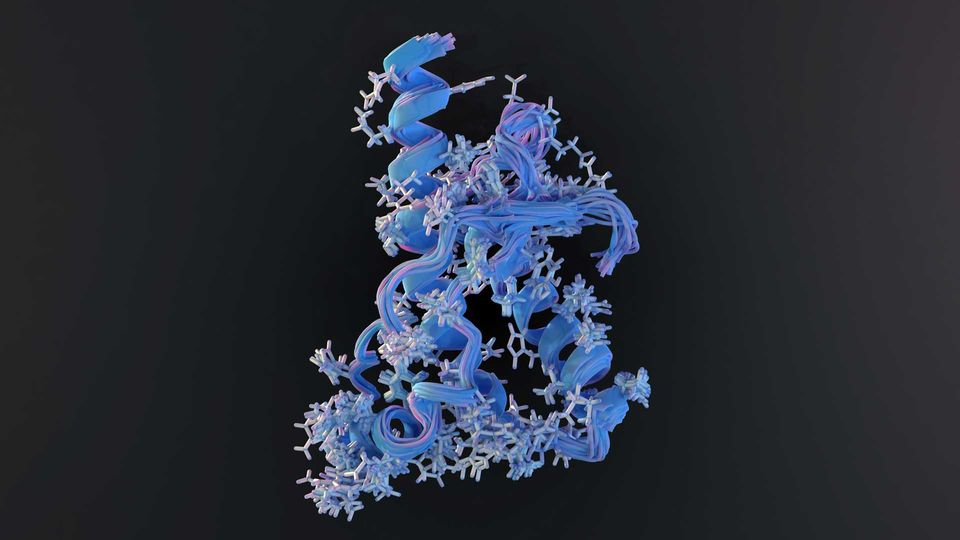Transmissible Alzheimer’s Disease: What Is a Prion?
A new study suggests that Alzheimer’s proteins may spread in a “prion-like” fashion. So, what is a prion, and how does this finding change what we know about Alzheimer's?

Complete the form below to unlock access to ALL audio articles.
A new study has reported that a now-banned medical procedure may have unintentionally infected patients with Alzheimer’s disease-causing proteins. Between 1959 and 1985, patients with short stature were offered human growth hormone (hGH) to increase their height. At this time, however, the hormone was extracted from human cadavers. Nearly 2,000 people received this procedure. Many received multiple injections over several years. In 1985, it became apparent that some people had been infected by hGH batches containing prion proteins that caused the fatal neurodegenerative disorder Creutzfeldt-Jakob disease (CJD), also known as “Mad Cow Disease” for its effects on cattle.
Now, researchers report that some of these hGH samples might also have been contaminated with amyloid-beta, a protein thought to be linked to the onset of Alzheimer's disease, the leading form of dementia. Eight patients in the study started developing neurological symptoms of Alzheimer’s when they were aged between 38 and 55. The most common form of Alzheimer's – sporadic Alzheimer’s – affects people later in life. Early onset symptoms are usually linked to a rare genetic form of the condition. However, these patients had no gene markers indicating they might develop this form of the condition.
Instead, the study authors now suggest that the patients are the first cases of iatrogenic Alzheimer's –a form of the disease caused by a medical treatment. They suggest that Alzheimer’s proteins may spread in a “prion-like” fashion. So, what is a prion, and how does this finding change what we know about Alzheimer's?
What are prions?
Prions are malformed versions of protein molecules. Proteins normally fold themselves into complex 3D structures. This helps them bind to other molecules. It is thought that many different proteins can form prion-like arrangements, although one particular protein, called prion protein (PrP) is at the root of many common prion diseases. PrP’s function in the healthy body is not yet known.
How do prions form?
The key event that kicks off prion formation and disease is the conversion of a normal protein – often PrP – into a prion structure. It’s not yet clear what prompts this change, but numerous gene variants have been linked to an increased risk of prion formation. The variant structure is very stable and very infectious. The presence of one prion appears to encourage other proteins to adopt the same conformation by acting as a template to refold the non-infected protein. Within infected tissues, prion proteins spread and bind together into structures called amyloid fibrils. Once they have formed into a prion conformation, it is incredibly hard to destroy the protein structure, meaning fibrils build up inside infected tissues.
What are prion diseases?
Prion diseases, like CJD, scrapie and kuru, tend to affect the brain and nervous system. Once amyloid fibrils made up of prion proteins start spreading through the brain, cells begin to break down, resulting in behavioral changes like dementia, movement disorders and ultimately death. Prion diseases have three classifications, depending on how the disease was spread. These are:
- Sporadic
- Inherited
- Acquired
In humans, sporadic disease is the most common form of prion disease – 85% of CJD cases are sporadic. Mutations in the PRNP gene that codes for PrP can cause inherited, genetic versions of these diseases. Acquired disease is very rare. One disease, kuru, has been noted in the Fore people of Papua New Guinea, who were thought to have been infected through their practice of ritualistic cannibalism, which continued up until the 1960s. These conditions often have an asymptomatic period, which can last for decades. Prions diseases are zoonotic and can move between infected animals and humans, although this is a rare occurrence.
Iatrogenic prion disease is rare but made possible because prions resist breakdown during normal decontamination procedures. A recent study even found that immersion of 40% household bleach for five minutes was ineffective at preventing some forms of prion spread.
Is Alzheimer's a prion disease?
The new study showing that Alzheimer’s disease can be acquired is just the latest piece of evidence linking the condition to prion disease. Alzheimer’s disease shares many of the same features:
- Proteins – amyloid beta and tau – are at the root of Alzheimer's pathology.
- These proteins spread throughout the brain like misfolded PrP.
- Amyloid beta forms into fibrils and sheets, like misfolded PrP.
- Alzheimer’s disease is usually sporadic but can be inherited. The latest study shows that it can also be acquired in humans.
One piece of evidence that argues against this theory is the observation that amyloid oligomers – small chunks of aggregated protein that have not formed into fibrils – appear to drive Alzheimer’s disease. Stanley B. Prusiner, director of the Institute for Neurodegenerative Diseases at the University of California, San Francisco (UCSF), has put his weight behind the idea that Alzheimer’s disease is a “double prion” disease – where both amyloid beta and tau “destroy the brain”. Prusiner, who received the 1994 Nobel Prize for his work in prions, said in a press release that this recognition should provoke a “major change” in Alzheimer’s research. Whether news of a medically acquired form of Alzheimer’s will bring that change closer remains to be seen.


